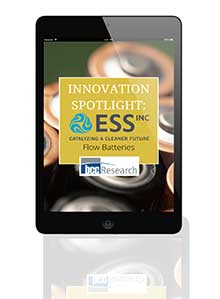Innovation Spotlight: ESS Inc: Flow Batteries
We all need reliable, cheap, scalable, and environmentally friendly sources of electricity. But, the real world, always having a sense of humor, has thrown us a curveball: There's a fundamental problem with renewable energy. It's called load balancing.
On an electricity grid, the total amount of electricity generated at each instant must equal the electricity load demand at that exact instant. When millions of users use air-conditioners in the afternoon during a heatwave, load-following power plants increase generation and many small, quick-to-start but expensive-to-run peaking power plants come online to meet total demand. When temperatures cool and air-conditioners cycle off, load-following plants wind down and the grid returns to a baseload generation profile. The next day, the cycle begins again.
Flow batteries—rechargeable electrochemical cells where chemical energy is produced by two chemical components dissolved in electrolyte liquid—are gaining significant traction among all the technologies mentioned above due to their sustainability for large-scale storage applications. Flow batteries also are among the safest batteries and have a long lifecycle, making them highly suitable for large-scale long-term storage applications. Furthermore, advancements in flow battery technologies reduce system costs, which is another favorable indicator for flow battery users.
BCC interviewed ESS Inc., a manufacturer of long-duration iron flow batteries for commercial and utility-scale energy storage applications. In Dec 2020, ESS Inc was named a 2021 Global Cleantech 100 Company by Cleantech Group. This is the third time ESS Inc. has been included on the widely recognized list, receiving similar honors in 2017 and 2020.
Download Innovation Spotlight

